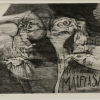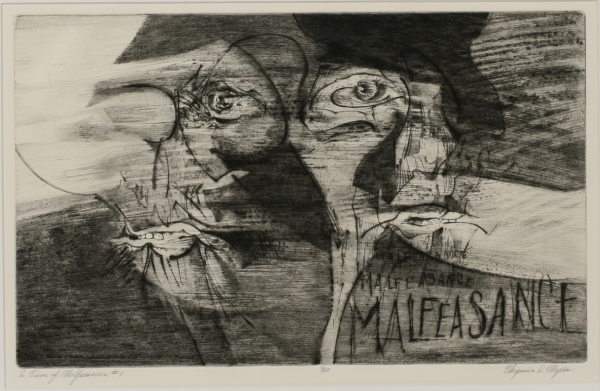Malfeasance Manifest
| Grade | 9th -12th Grades | Class | Length of Lesson | Approximately 5 - 6 (40 minute sessions) |
| Lesson Title | Malfeasance Manifest |
| Unit Title | Individual and Collective Representations: Virginia Myers |
| Unit Compelling Question | What does representation mean? |
| Historical Context: WHO: Virginia Myers WHEN: 1927-2015 WHAT: American Printmaker FAMOUS FOR: Expert artist, scholar, professor, and inventor of Iowa Foil Printer. IN HER OWN WORDS: ARTIST'S HISTORY: IOWA CONNECTIONS: ARTIST'S WORK: ARTIST'S WORLD: |
|
| Lesson Supporting Question | |
| Lesson Overview | Students will learn about the life and influence of artist Virginia Myers, who was an artist, printmaker, and inventor in Iowa. Using Myers’ artwork, A Time of Malfeasance No. 1, 1974, as inspiration, students will create a large charcoal drawing depicting an event or example of malfeasance in US history and law. Students will research and understand the meaning of malfeasance, use the medium of charcoal to create a large drawing, and then write an artist statement describing the process and message of their artwork. |
| Primary Sources Used |
|
| Resources Needed | Other Notable Artworks: To Iowa and Molly Brooks, 1959 Alone, 1959 A Codex of Our Times, 2014 Online Resources (Used at Instructor's Discretion): FIRST-PERSON NARRATIVE: Virginia Myers VIDEO: Learn about the Iowa Foil Printer & the hot stamped foil print-making process VIDEO: Hot Foil Printing - How It Works VIDEO: Intro to Printmaking ARTICLE: Malfeasance ARTICLE: What is malfeasance? Materials: Access to internet Print/Copy/On Screen image of artwork A Time of Malfeasance No. 1, 1974 Sketch materials as desired Large (18” x 24”) drawing paper Variety of drawing charcoal (vine, pencils, compressed) Kneaded eraser Blending stick |
| Standard | |
| Lesson Target | Students will analyze and discuss the artwork and life of artist Virginia Myers and her connections to The University of Iowa in Iowa City.;Students will will create a charcoal drawing depicting an event or example of malfeasance in U.S. history.;Students will research and write an artist statement and rationale explaining the process and message of their artwork. |
| Lesson Themes | Innovators, Women's Experience, Visual Arts, Lawmaking |
|
| Formative Assessment (How will you use the formative assessments to monitor and inform instruction?) |
Class discussions and malfeasance research. |
| Summative Assessment (How does the lesson connect to planned summative assessment(s)?) |
Completed charcoal drawings and artist statements. |
| Author | Megan Dehner | Created | Last Edited | ||||
| Reviewer: Teaching Iowa History Team | |||||||
| Lesson Plan Development Notes: Summer Fellowship 2022 | |||||||


